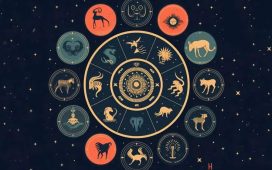Join our daily and weekly newsletters for the latest updates and exclusive content on industry-leading AI coverage. Learn More
Napkin is an AI-based tool for visual storytelling for business people to bring life to their presentations using generative AI.
It comes from Silicon Valley AI veteran Pramod Sharma and Jerome Scholler, who started Osmo more than a decade ago to use AI to bring children’s games to life on iPads. I covered their rise and exit, and Sharma came back to me to do an interview on his next big idea.
Why is it called Napkin? If you have an idea and write it on a napkin — the classic start of many Silicon Valley companies — then it will generate the art and presentation to go with it automatically.
Los Altos, California-based Napkin has created a tool that empowers you to explain your ideas visually with no effort. You write out your text for a business presentation and, using Visual AI, it will quickly turn your text content into visuals and easily adjust the style, colors, fonts, shapes, and design to improve your storytelling impact.
I watched Sharma do a demo and he took text and the tool generated flow charts, pie charts and more to illustrate text ideas. And it wasn’t just generating something perfect every time. Napkin gives you the power to edit everything and make it just right, he said. You can modify titles, captions, and other pieces of an illustration to bring it into something that is more precisely what you want, Sharma said in our interview.
Currently in beta, Napkin works with your current workflow in Google Docs, Slides, Canva, Slack, Word, PowerPoint, Email, Text, and more. No longer do you have to wait for someone who knows what they’re doing to generate prototypes of your presentations. Napkin will continuously introduce new styles and designs to meet your storytelling needs.
In an interview with VentureBeat, Sharma said that we all have ideas, but effectively communicating them and winning people over is no easy feat. As attention spans shrink and we hit peak information overload, how can we best communicate complex ideas? Napkin turns your text into visuals without your having to think about the laborious design complexities.
Napkin is pioneering visual AI that brings impact and fun into business storytelling. It’s designed for the millions of professionals who sell ideas, writers, educators, and content creators, Napkin helps you unlock the visual potential in your text content. And it’s for those of us who may be good writers but are lousy at graphics, presentations or artistry (raises hand).
“With the iPhone, Apple made it dead simple for anyone to take photos. We aim to do the same thing with graphics,” said Sharma. “Visuals are powerful, and we’ve designed Napkin so anyone can easily communicate their ideas through imagery.”
It’s not just about getting rid of jobs or eliminating graphic designers. Rather, Sharma said that it’s more about making design more accessible, enabling you to explain your ideas without spending hours creating the right visual and building it from scratch.
How it works

Here’s how it works:
- Bring Your Text: Paste your existing text content or generate text from an AI prompt.
- Generate Visuals: Click the “spark icon” on any part of the text, and Napkin will transform your content into recommended visuals. Within a few seconds, you’ll have a variety of visuals to choose from.
- Customize: With Napkin’s built-in editing tool, you can adjust font, color, shape, design, and more to meet your style or brand guidelines.
- Embed into Your Workflows: As simple as copying and pasting, you can simply take Napkin’s visuals into any place you like: Google Slides/Docs, Microsoft Word/PowerPoint, Substack, Medium, Slack, Notion, Canva, LinkedIn, X, Instagram and more.
- Use it in a Diversity of Use Cases: Create high-quality visuals suitable for presentations, blogs, pitch decks, social content, newsletters, data and research reports, customer communications, and more.
“As someone without design skills, Napkin is super easy and convenient. Whether I need a quick diagram for a blog post or a chart for a presentation, Napkin generates exactly what I’m looking for within seconds,” said Jason Miller, COO of Sprouts.ai, in a statement. “Before Napkin, we were constrained regarding what graphics we could access. Now, with Napkin, we have a designer at our fingertips, offering unlimited access to enhance our business storytelling with visuals while achieving significant cost and time savings.”
Instant visuals to amplify storytelling
Napkin’s vast design catalog already includes more than 30 visual design categories, such as mind maps, flow charts, Venn diagrams, bar charts, and more.
Napkin’s team of NLP, AI, and computer vision developers, who hail from Amazon, Microsoft’s Research Lab, GitHub, Google, and Osmo, is hard at work supporting more powerful customizations and unique categories, which they will continue to launch in the coming weeks and months.
Scholler and Sharma sold their previous company, Osmo, whose reflective AI is used by millions of kids and classrooms and is integrated into products with Disney and Mattel’s Hot Wheels. Byju’s acquired it for $120 million in 2019.
Inspiration

In a blog post, Sharma said effective communication is crucial in the workplace, whether you’re pitching an idea, explaining complex concepts, or brainstorming new strategies. How do you make sure that your vision is understood and appreciated by others? This challenge inspired the team to build Napkin AI.
“We all have great ideas, but sharing them effectively can be a struggle. At Osmo, an AI gaming company Jerome and I founded almost a decade ago, we delighted millions of kids by making learning fun,” Sharma wrote. “Yet, as leaders, we often found ourselves drowning in documents, 100-slide decks, and long research papers. Occasionally, we’d come across a rare visual that truly captured the essence of an idea, sparking those “aha” moments of clarity. We realized that visuals are powerful communication tools, yet they are rarely used.”
He added, “We started wondering why so few people use visuals when they’re such powerful tools for communication. Our theory is that, from an early age, we’re trained to rely on writing. Text editors make it easy for everyone to collaborate and share their thoughts. However, creating visuals is time-consuming and requires skills many of us don’t have. As a result, most people stick to writing, even though visuals can provide a clearer, more impactful perspective of an idea. This is especially true in professional settings where effective communication is very important.”
At Osmo, he said the founders spent a lot of time on communication, reading proposals, writing talks, creating slides, doing research papers, and communicating back and forth.
“It’s very daunting to consume all that information. And as we were looking into it, we realized that one thing we always loved about communication was visual.”
“We realized it’s incredibly hard to make good pictures of things that you’re talking about,” he said. “Most people have been using generative AI for and for social media. That seems like where everybody gravitated at first.”
But the founders thought small business and the enterprise were the right way to go with AI visuals. The graphics can get pretty complex with interactivity. You can specify boundaries of what you want before you submit the idea to the AI.
“We realized is most people know how to write but they don’t know how to create a visual,” Sharma said.
But making this look easy is the hard part.
The team is small with 11 people and they spent more than a year and a half working on tools.
“We realized that most people don’t have the layer of creativity or the time to come up with something,” Sharma said. “Very few people can actually start from scratch. And only in our third generation did we realize that what people really want is AI.”
“It’s extremely hard. We are building something almost like a visual engine. I give you bunch of information, and you create the right graphic and dynamically create graphics,” Sharma said.
Rather than produce wild and imaginative art, Napkin focuses on visuals for information. It’s not Salvador Dali.
“We’re trying to complement the written content,” Sharma said.
The first version of an AI tool came in the form of a sketching tool to make simple diagrams with your mouse. However, the team quickly discovered that even with the best AI helping in the background, users don’t want to sketch live with a mouse.
In the second version, the creators introduced a database of visual frameworks like Venn diagrams and pie charts. Users could focus on finding a visual to use that matched their ideas, instead of sketching. But they discovered that many people don’t know which visuals to use or how to use them effectively, even if they have access to them.
Finally, the introduction of Large Language Models (LLMs) provided the perfect complement to the team’s efforts. They focused on transforming text into visuals automatically, meeting users where they are most comfortable – writing text. This marked the birth of the Napkin AI you see today.
Looking Ahead

Just as the iPhone made it easy for anyone to take high-quality images, Napkin AI’s mission is to make visual communication easy and accessible to everyone, Sharma wrote.
“We understand it’s a really hard problem, and we have just started, but we are excited about the progress we’ve made so far. We believe we can achieve our mission by focusing on two core principles: deeply understanding text content and generating a wide range of relevant and high-quality visuals,” he wrote.
Accel and CRV are the investors in the project. You can write them at team@napkin.ai and join the beta at napkin.ai.
READ SOURCE








